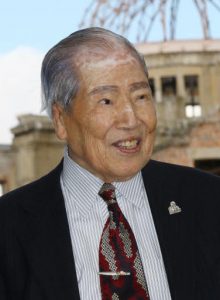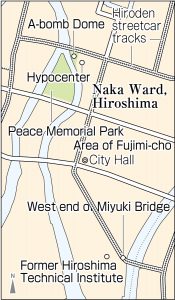Sunao Tsuboi, survivor of Hiroshima atomic bombing and co-chair of Nihon Hidankyo, dies at 96
Oct. 28, 2021
Spent life striving to eliminate nuclear weapons
by Kyosuke Mizukawa, Staff Writer
Sunao Tsuboi, co-chairperson of the Japan Confederation of A- and H-bomb Sufferers Organizations (Nihon Hidankyo), died at a Hiroshima hospital on October 24 at 10:35 a.m. He was 96. The cause of death was cardiac arrhythmia associated with anemia. The announcement of his passing was made by the Hiroshima Prefectural Confederation of A-bomb Sufferers Organization (Hiroshima Hidankyo), an organization for which he served as chairperson. Mr. Tsuboi, originally from the area of Ondo-cho in Kure City and a resident of Hiroshima City’s Nishi Ward, strived to eliminate nuclear weapons and generate support for A-bomb survivors by communicating his A-bomb experiences to people in Japan and overseas. His wake and funeral were held on October 25 and 26th, respectively, with only family members attending, in accordance with Mr. Tsuboi’s wishes.
On August 6, 1945, when the U.S. military dropped the atomic bomb on Hiroshima, Mr. Tsuboi was a third-year student at the Hiroshima Technical Institute (now the Faculty of Engineering at Hiroshima University). He was walking in the Fujimi-cho area of Hiroshima (now part of the city’s Naka Ward) on the way back to his dormitory to pick up his belongings when the bomb detonated. He was about 1.2 kilometers from the hypocenter and, as a result, suffered burns over his entire body.
He fled to the west end of Miyuki Bridge, located in Hiroshima’s Naka Ward, and with a small stone, wrote on the ground “Tsuboi died here.” He was taken to a field hospital on Ninoshima Island (now part of Hiroshima’s Minami Ward), located in Hiroshima Bay. Later, his mother found him and brought him back to his hometown of Ondo in Kure City. He did not regain consciousness until September 25 of the same year.
After recovering, he chose the career path of junior high school math teacher. He would speak about his A-bombing experience to his students, who nicknamed him Mr. “Pika-don,” an expression describing the flash (pika) and blast (don) from the bombing. However, he was repeatedly hospitalized due to bouts with aplastic anemia and cancer, which were the result of exposure to radiation. He found himself in critical condition three times but, each time, miraculously survived and recovered.
After retiring in March 1986, Mr. Tsuboi began his involvement in the A-bomb survivors’ movement. He became secretary-general of the Hiroshima Hidankyo in 1994 and began his tenure as the organization’s chair in 2004. He started work as co-chair of Nihon Hidankyo in 2000. As the so-called “Face of Hiroshima,” Mr. Tsuboi shared his A-bombing experience at different locations throughout the world, including New York City, a visit timed to coincide with the holding of the 2010 Review Conference of the Parties to the Treaty on the Non-Proliferation of Nuclear Weapons (NPT) in that city.
In 2016, he was invited to Hiroshima Peace Memorial Park, located in the city’s Naka Ward, on the occasion of Barack Obama’s 2016 visit as the first sitting U.S. president to visit Hiroshima. As Mr. Tsuboi shook hands with Mr. Obama, he said, “Let’s work together to eliminate all nuclear weapons.”
In the same year, he became one of the promoters of the Hibakusha Appeal, an international signature drive launched to urge governments of the world to conclude a treaty to ban and eliminate nuclear weapons. Mr. Tsuboi went out on the streets himself to call on people to provide their signatures. The collected signatures were sent to the United Nations, providing momentum behind the July 2017 establishment of the Treaty on the Prohibition of Nuclear Weapons (TPNW). Because of his advanced age and health issues, he had not been able to attend public events for the past several years.
(Originally published on October 28, 2021)









